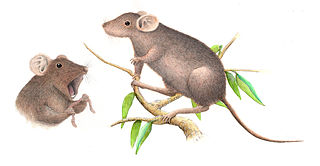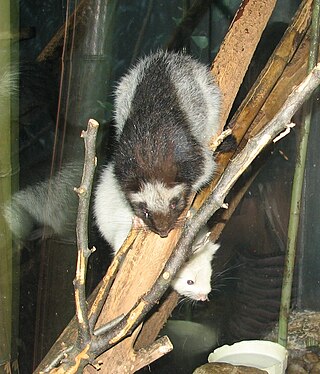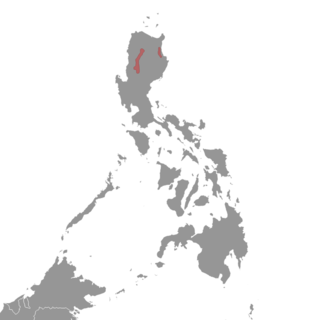
The Old World rats and mice, part of the subfamily Murinae in the family Muridae, comprise at least 519 species. Members of this subfamily are called murines. In terms of species richness, this subfamily is larger than all mammal families except the Cricetidae and Muridae, and is larger than all mammal orders except the bats and the remainder of the rodents.
Sommer's Sulawesi rat is a species of rodent in the family Muridae from Sulawesi. It is the only species in the genus Sommeromys and was described by Musser & Durden in 2002.

Apomys, commonly known as earthworm mice, is a genus of rodent endemic to the Philippines. Mice belonging to this genus are generally called Philippine forest mice and can be found on most islands of the Philippines except in Palawan, the Sulu Archipelago, and the Batanes and Babuyan group of islands.

Batomys is a genus of rodent endemic to the Philippines. It has six extant described species.

The cloud rats or cloudrunners are a tribe (Phloeomyini) of arboreal and nocturnal herbivorous rodents endemic to the cloud forests of the Philippines. They belong to the family Muridae and include five genera: Batomys, Carpomys, Crateromys, Musseromys, and Phloeomys. They range in size from as large as 50 cm (20 in) to as small as 74 mm (2.9 in). Cloud rats are threatened by habitat loss and illegal hunting. Several species are endangered or critically endangered.

The shrewlike rats, genus Rhynchomys, also known as the tweezer-beaked rats are a group of unusual Old World rats found only on the island of Luzon in the Philippines. They look a great deal like shrews and are an example of convergent evolution. Shrewlike rats evolved to be vermivores and insectivores feeding on soft-bodied invertebrates associated with leaf litter.

The Luzon montane forest mouse is a species of rodent in the family Muridae, from the genus Apomys. It occurs only in the Philippines, where it has been found on the large northern island Luzon. It is most closely related to the large Mindoro forest mouse, which occurs on Mindoro. There may be another related species in the Sierra Madre, but this species is yet undescribed. The Luzon montane forest mouse is a relatively large, ground-dwelling rat with a tail that is quite short for its genus.

The Mount Isarog shrew-mouse is a species of rodent in the family Muridae found only in the Philippines. Its natural habitats include subtropical or tropical dry forest. It is threatened by habitat loss due to logging operations.
The Celebes shrew-rat is a species of rodent in the family Muridae. It is found only in Sulawesi, Indonesia. Its natural habitat is subtropical or tropical dry forests. It is threatened by habitat loss.

Crunomys is a genus of rodent in the family Muridae native to the Philippines and Sulawesi. It contains the following species:

The Northern Luzon shrew-rat is a species of rodent in the family Muridae. It is found only in the Philippines. Its natural habitat is subtropical or tropical dry forest. It is threatened by habitat loss.
The Sulawesian shrew rat is a species of rodent in the family Muridae. It is the only species in the genus Melasmothrix. It is found only in central Sulawesi, Indonesia, and is known from the localities of Rano Rano and Mount Nokilalaki.
Pseudohydromys is a genus of rodents in the family Muridae endemic to New Guinea. It contains the following species:

The Sierra Madre shrew mouse is a species of mammal from the Philippines.
Guy Graham Musser was an American zoologist. His main research was in the field of the rodent subfamily Murinae, in which he has described many new species.

The Katanglad shrew-mouse, also known as the Kitanglad shrew-mouse is a species of rodent in the family Muridae. It is known only from one specimen taken at 2250 m on Mount Kitanglad, Bukidnon Province, Philippines.
In mammals, ungual tufts are tufts of hairs at the base of claws of the forefeet and hindfeet. Their presence has been used as a character in cladistic studies of the Cricetidae, a large family of rodents.

The Kalinga shrew mouse is a rodent of the genus Soricomys found in the northern province of Kalinga, island of Luzon, in the northern Philippines.

Soricomys, the shrew-mice, are a genus of rodents in the family Muridae. They are carnivores that feed on invertebrates much like shrews do. An apparently smaller relatives of the true shrew-rats Chrotomys and Rhynchomys, Soricomys are somewhat convergent to the more distantly related Crunomys.
Danilo S. Balete, also known as Danny Balete, was a Filipino zoologist and biologist. His is known for his work on the Philippines' endemic mammal species. He pursued the question of what determines species diversity. The research by Balete and his team overturned previously held notions that diversity decreased in mountainous regions, showing that harsh environments could generate, rather than suppress, species diversity.











